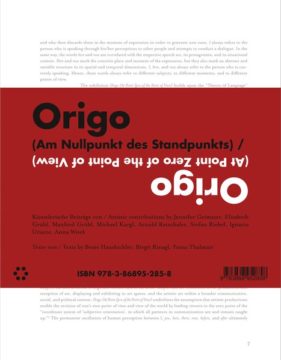vorherige ISBN 978-3-86895-285-8
Building upon the “Theory of Language”, formulated by Karl Bühler in the 1930s, the publication “Origo (At Point Zero of the Point of View)” explores questions on the variability of a person-dependent, individual, and thereby subjective point of view. The curatorial research is centred around the concept of the “origo”, which the psychologist and philosopher Bühler defined as the zero point of the personal, spatial, and temporal structure of a speech act, underlining the assumption that artistic productions enable the revision of one’s own standpoint and view of the world by leading viewers to the zero point of the “coordinate system of ‘subjective orientation’”.
The word “I” always refers to the person who is speaking through their perceptions to other people and attempts to conduct a dialogue. In the same way, the words “here” and “now” are correlated with the respective speech act, its protagonists, and its situational context. Hence, “I”, “here”, and “now” always refer to different subjects, to different moments, and to different standpoints. Who addresses whom in which relationship and with which intentions? Which different concepts, perceptions, and ideas are linked to one and the same artistic expression? How does the perspective of the producer manifest in the act of artistic expression and that of the recipient in the process of perception?
The catalogue „Origo (At Point Zero of the Point of View)“ is published on the occasion of the correspondent exhibition at the Kunsthalle Exnergasse in Vienna and contains an exhibition documentation with installation views as well as with a curatorial statement by Birgit Rinagl and Franz Thalmair. Furthermore Beate Hausbichler, freelance journalist and editor of the feminist online-magazine dieStandard.at, situates the exhibition in a philosophical and sociological context. The participating artists—Jennifer Grimyser, Elisabeth Grübl and Manfred Grübl, Michael Kargl, Arnold Reinthaler, Stefan Riebel, Ignacio Uriarte as well as Anita Witek—expand the topic of the exhibition with artistic contributions especially made for the book.
- Veröffentlicht am Sonntag 19. Mai 2024 von Revolver Publishing
- ISBN: 9783957630810
- 88 Seiten
- Genre: Hardcover, Kunst, Softcover
